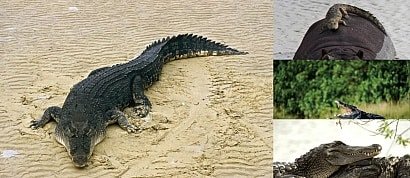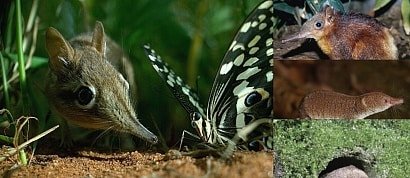A list of my favorite images of muskrats.
en.wikipedia.org/wiki/Muskrat
The muskrat (Ondatra zibethicus), the only species in genus Ondatra and tribe Ondatrini, is a medium-sized semiaquatic rodent native to North America, and is an introduced species in parts of Europe, Asia and South America.
The muskrat is found in wetlands over a wide range of climates and habitats. It has important effects on the ecology of wetlands and is a resource of food and fur for humans.
The muskrat is the largest species in the subfamily Arvicolinae, which includes 142 other species of rodents, mostly voles and lemmings.
Muskrats are referred to as "rats" in a general sense because they are medium-sized rodents with an adaptable lifestyle and an omnivorous diet. They are not, however, so-called "true rats", that is, members of the genus Rattus.
An adult muskrat is about 40–70 cm (16–28 in) long, half of that is the tail, and weighs from 0.6–2 kg (1.3–4.4 lb).
Muskrats are covered with short, thick fur which is medium to dark brown or black in color, with the belly a bit lighter (countershaded); as the age increases, it turns a partly gray in color. The fur has two layers, which helps protect them from the cold water.
They have long tails covered with scales rather than hair and, to aid them in swimming, are slightly flattened vertically, which is a shape that is unique to them. When they walk on land, their tails drag on the ground, which makes their tracks easy to recognize.
Muskrats spend much of their time in the water and are well suited for their semiaquatic life. They can swim under water for 12 to 17 minutes. Their bodies, like those of seals and whales, are less sensitive to the buildup of carbon dioxide than those of most other mammals.
They can close off their ears to keep the water out. Their hind feet are semi-webbed, although in swimming, their tails are their main means of propulsion.
Muskrats normally live in groups consisting of a male and female pair and their young. During the spring, they often fight with other muskrats over territory and potential mates. Many are injured or killed in these fights. Muskrat families build nests to protect themselves and their young from cold and predators.
In streams, ponds or lakes, muskrats burrow into the bank with an underwater entrance. These entrances are 6–8 inches wide. In marshes, push-ups are constructed from vegetation and mud. These push-ups are up to three feet in height. In snowy areas, they keep the openings to their push-ups closed by plugging them with vegetation, which they replace every day.
Some muskrat push-ups are swept away in spring floods and have to be replaced each year. Muskrats also build feeding platforms in wetlands. They help maintain open areas in marshes, which helps to provide habitat for aquatic birds.
Muskrats are most active at night or near dawn and dusk. They feed on cattails and other aquatic vegetation. They do not store food for the winter, but sometimes eat the insides of their push-ups. While they may appear to steal food beavers have stored, more seemingly cooperative partnerships with beavers exist.
Plant materials make up about 95% of their diets, but they also eat small animals, such as freshwater mussels, frogs, crayfish, fish and small turtles. Muskrats follow trails they make in swamps and ponds. When the water freezes, they continue to follow their trails under the ice.
Muskrats, like most rodents, are prolific breeders. Females can have two or three litters a year of six to eight young each. The babies are born small and hairless, and weigh only about 22 grams (0.8 oz).
In southern environments, young muskrats mature in six months, while in colder northern environments, it takes about a year. Muskrat populations appear to go through a regular pattern of rise and dramatic decline spread over a six- to 10-year period.
Added to
People who voted for this also voted for
Vanessa Redgrave - Favorite Movies
U.S.M.C., Semper Fidelis
When I was 32... book diary, May/June 2015
Journalist/Reporter - Movies
Remember? part II
Anne Bancroft - Favorite Movies
Alicia Fox
Marcello Dudovich' "Simplicissimus" Artworks_2
Animal World, Part 2; Them And Us
Anautix' favorite Soul, R&B
But The Sign Says; Irony
Stan Laurel And Oliver Hardy's Comedies_2
When I was 31... music diary, December 2014
Liberal Logic, part VII; Stupid Liberal Quotes
♫ A little bit of '84
More lists from kathy
Favorite Fictional Dragons
Favorite Images of Capuchin Monkeys
Favorite Pluto Cartoons #1
Favorite Songs Discovered Through Listal #3
Favorite Images of Crocodiles
Favorite Images of Shrews #1
Favorite Nancy Sinatra Songs
 Login
Login





















































